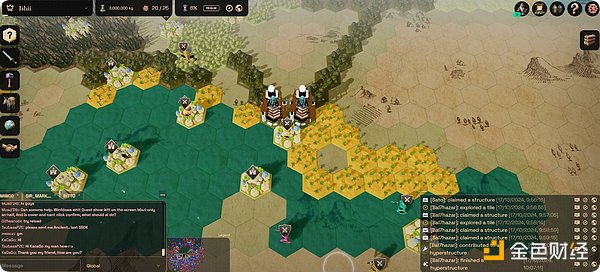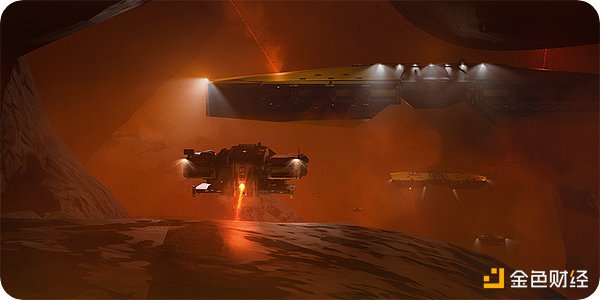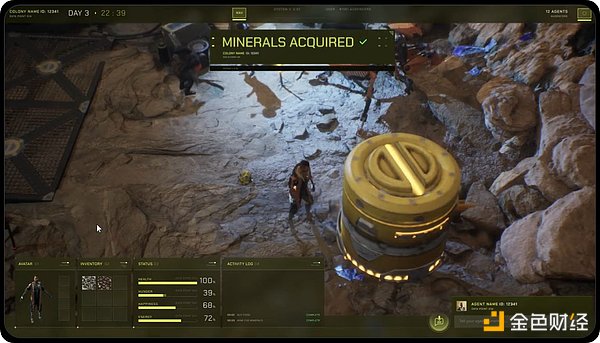Author: William M. Peaster, Bankless; Translator: Deng Tong, Golden Finance
Recently, crypto games have tended to be more complex and open. We are moving from simple experiences to vast virtual world projects.
You can see this all around us now, as multiple new games here are trying to push the limits with immersive economies, player-driven governance, and gameplay that rewards collaboration and strategic depth.
1. Eternum on Starknet

Eternum is a new on-chain massively multiplayer online game (MMO) that will be available on Starknet in the fourth quarter of 2024. It blends elements of 4X (explore, expand, exploit, and exterminate) and real-time strategy (RTS) games in a dynamic, fully on-chain world with a player-driven economy.
The big idea? Players navigate an endless hexagonal map, forming alliances or rivals, gathering resources, and vying for control in a strategic struggle for dominance. With an emphasis on diplomacy and resource management, Eternum requires players to balance cooperation and competition to succeed.
Each player starts with a realm that they can expand and grow, using resources that can even be converted into tokens to be traded through $LORDS. The game also introduces “hyperstructures” as high-stakes strategic objectives – building these can lead to victory, but comes at the risk of being attacked by enemies, so defense is crucial.
Looking beyond the obvious, Eternum is composable, meaning it can be modified and extended by the community thanks to the Dojo on-chain game engine. The game also uses Cartridge’s on-chain gaming stack, with tools like session keys and Paymaster support to streamline the user experience.
Remember that the launch of Eternum is just one aspect of the larger vision of Realms World, an interconnected ecosystem of on-chain games on Starknet.
Realms World is designed to operate across two layers: a flexible public layer for game creation and modification, and a stable core layer that acts as a "digital-physical" layer with governance control standards. This layered design will allow multiple games (like Eternum) to coexist, share state, and interact in unique ways, so keep an eye on the experiments here.
2.EVE Frontier on Redstone

EVE Frontier is a space survival game developed by CCP Games, the creators of the popular EVE Online MMO, which has been a pioneer in game economics for two decades.
EVE Frontier is currently being built on Redstone, a second-layer network designed for gaming and autonomous worlds, which will take players into a decaying universe. The biggest challenge? Rebuilding civilization while dealing with limited resources, fierce competition, and rogue AI.
The game’s “single-shard” universe is powered by CCP’s custom (and soon-to-be-open-source) Carbon engine and MUD, a popular on-chain gaming framework built by Lattice that lets players program and modify aspects of the game world in real time.
At the heart of the architecture are Frontier’s “Smart Components” — modular, programmable structures that players can build and deploy in space. These can be storage units or complex, interactive entities like trading stations, defense systems, or even tasking structures.
Smart Components also unlock a wide range of possibilities for third-party developers, like writing automated marketplaces, bounty boards, and even private economies. The idea is to add layers of tactical depth and personal expression to the game.
Like Eternum, EVE Frontier’s economy will be entirely player-driven, designed with open ownership and real-world value in mind. Built on the ERC-20 and ERC-721 token standards, the economy will be open to trading, and players will be able to create custom assets and currencies in the game, mirroring the deep economy capabilities pioneered by EVE Online.
3. Parallel Colony on Solana

Parallel Colony is an upcoming game developed by Parallel Studios, the company best known for its collectible card game Parallel. Colony is set in the Echelon Prime ecosystem, which revolves around the $PRIME token, but it is developed on Solana instead of the Ethereum + Base combination used by major TCGs.
That being said, Solana will come in handy in facilitating the high-speed transactions necessary to manage the game’s complex AI interactions. That’s because Colony is centered around AI-powered avatars that can act autonomously, learning and adapting to the game’s survival imperatives along the way. This will create an environment where human players are like mentors to their agents.
Holders of the original Parallel Avatar NFT on Ethereum will still be able to easily participate, though, and $PRIME will be used to create new avatars as NFTs on Solana. Each of these avatars starts with a basic profile shaped by the player’s choices, but their personalities quickly evolve as they experience and learn. Additionally, these AI avatars have their own digital wallets and trade in-game assets based on their goals.
It’s worth noting that the underlying AI infrastructure here is Wayfinder, a full-chain AI agent protocol that will facilitate the autonomy of in-game avatars without constant input from players. Through “pathfinding,” these avatars can efficiently navigate cross-chain environments, enabling them to buy, sell, and interact with in-game assets while learning from past experiences.
While Colony will offer a free-to-play model, it’s not the same as traditional free-to-play games. Free avatars will be able to explore and interact, but will not be able to earn $PRIME or mint in-game assets as NFTs. Free players will still need to fund their avatar's in-game transactions, such as paying for Large Language Model (LLM) calls, etc. In other words, full rewards and ownership will be reserved for players who directly participate in the Echelon Prime ecosystem.
 Hui Xin
Hui Xin
 Hui Xin
Hui Xin Jixu
Jixu Jixu
Jixu Jixu
Jixu Davin
Davin Aaron
Aaron Hui Xin
Hui Xin Jasper
Jasper Joy
Joy Aaron
Aaron